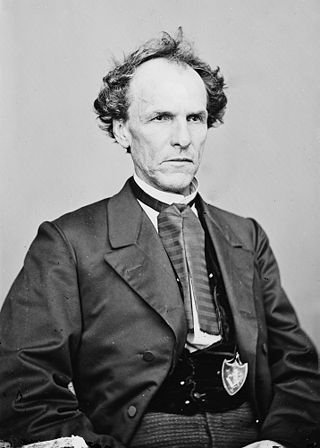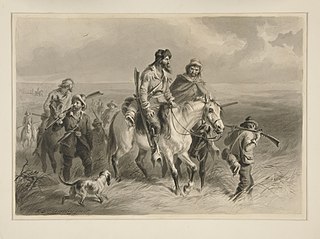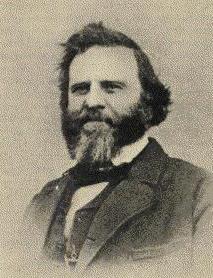The Leavenworth Constitution was one of four Kansas state constitutions proposed during the era of Bleeding Kansas. It was never adopted. The Leavenworth Constitution was drafted by a convention of Free-Staters, and was the most progressive of the four proposed constitutions. The conspicuous aspects of this Constitution were a Bill of Rights that referred to "all men" (making no distinction between the rights of white men and Black men), the banning of slavery from the state, and a basic framework for the rights of women.
The constitutional convention that framed the Leavenworth Constitution was provided for by an act of the Territorial Legislature passed in February 1858, during the pendency of the Lecompton Constitution in Congress. The constitution was adopted by the convention at Leavenworth April 3, 1858, and by the people at an election held May 18, 1858.
The Leavenworth Constitution did not have a great impact on the history of Kansas since the US Senate did not approve of the codified laws in the written document. The other proposed state constitutions were the Topeka Constitution (1855), the Lecompton Constitution (1857) and the Wyandotte Constitution (1859). The proposed Wyandotte Constitution became the constitution of Kansas when it was admitted to the union in 1861.
Wikisource has original text related to this article:

Lecompton is a city in Douglas County, Kansas, United States. As of the 2020 census, the population of the city was 588. Lecompton was the de jure territorial capital of Kansas from 1855 to 1861, and the Douglas County seat from 1855 to 1858. Anti-slavery Lawrence became the de facto capital during the latter part of this period, when the county seat was moved there. This time period was known as Bleeding Kansas, due to the violence perpetrated by the pro-slavery, and to a lesser extent the anti-slavery, factions in the eastern part of the state. Lecompton was a hotbed of pro-slavery sentiment during the mid-1800s.
The U.S. state of Kansas, located on the eastern edge of the Great Plains, was the home of nomadic Native American tribes who hunted the vast herds of bison. In around 1450 AD, the Wichita People founded the great city of Etzanoa. The city of Etzanoa was abandoned in around 1700 AD. The region was explored by Spanish conquistadores in the 16th century. It was later explored by French fur trappers who traded with the Native Americans. Most of Kansas became permanently part of the United States in the Louisiana Purchase of 1803. When the area was opened to settlement by the Kansas–Nebraska Act of 1854 it became a battlefield that helped cause the American Civil War. Settlers from North and South came in order to vote slavery down or up. The free state element prevailed.

Bleeding Kansas, Bloody Kansas, or the Border War was a series of violent civil confrontations in Kansas Territory, and to a lesser extent in western Missouri, between 1854 and 1859. It emerged from a political and ideological debate over the legality of slavery in the proposed state of Kansas.

The Territory of Kansas was an organized incorporated territory of the United States that existed from May 30, 1854, until January 29, 1861, when the eastern portion of the territory was admitted to the Union as the free state of Kansas.

The Lecompton Constitution (1858) was the second of four proposed constitutions for the state of Kansas. Named for the city of Lecompton where it was drafted, it was strongly pro-slavery. It never went into effect.

Brigadier-General James Henry Lane was an American politician and military officer who was a leader of the Jayhawkers in the Bleeding Kansas period that immediately preceded the American Civil War. During the war itself, Lane served in the United States Senate and as a general officer in the Union Army. Although reelected as a Senator in 1865, Lane died by suicide the next year.
In the United States, each state has its own written constitution.

Border ruffians were proslavery raiders who crossed into the Kansas Territory from Missouri during the mid-19th century to help ensure the territory entered the United States as a slave state. Their activities formed a major part of a series of violent civil confrontations known as "Bleeding Kansas", which peaked from 1854 to 1858. Crimes committed by border ruffians included electoral fraud, intimidation, assault, property damage and murder; many border ruffians took pride in their reputation as criminals. After the outbreak of the American Civil War in 1861, many border ruffians fought on the side of the Confederate States of America as irregular bushwhackers.
The Wyandotte Constitution is the constitution of the U.S. state of Kansas.

The Topeka Constitutional Convention met from October 23 to November 11, 1855 in Topeka, Kansas Territory, in a building afterwards called Constitution Hall. It drafted the Topeka Constitution, which banned slavery in Kansas, though it would also have prevented free blacks from living in Kansas. The convention was organized by Free-Staters to counter the pro-slavery Territorial Legislature elected March 5, 1855, in polling tainted significantly by electoral fraud and the intimidation of Free State voters.

The Kansas Legislature is the state legislature of the U.S. state of Kansas. It is a bicameral assembly, composed of the lower Kansas House of Representatives, with 125 state representatives, and the upper Kansas Senate, with 40 state senators. Representatives are elected for two-year terms, senators for four-year terms.

Free-Staters was the name given to settlers in Kansas Territory during the "Bleeding Kansas" period in the 1850s who opposed the expansion of slavery. The name derives from the term "free state", that is, a U.S. state without slavery. Many of the "free-staters" joined the Jayhawkers in their fight against slavery and to make Kansas a free state.

Frederick Perry Stanton was an American lawyer and politician who served in the United States House of Representatives for Tennessee's 10th congressional district and as Secretary of the Kansas Territory.
The timeline of Kansas details past events that happened in what is present day Kansas. Located on the eastern edge of the Great Plains, the U.S. state of Kansas was the home of sedentary agrarian and hunter-gatherer Native American societies, many of whom hunted American bison. The region first appears in western history in the 16th century at the time of the Spanish conquest of the Aztec Empire, when Spanish conquistadors explored the unknown land now known as Kansas. It was later explored by French fur trappers who traded with the Native Americans. It became part of the United States in the Louisiana Purchase of 1803. In the 19th century, the first American explorers designated the area as the "Great American Desert."

The presidency of James Buchanan began on March 4, 1857, when James Buchanan was inaugurated as 15th president of the United States, and ended on March 4, 1861. Buchanan, a Democrat from Pennsylvania, took office as the 15th United States president after defeating former President Millard Fillmore of the American Party, and John C. Frémont of the Republican Party in the 1856 presidential election.

Lecompton Constitution Hall, also known as Constitution Hall, is a building in Lecompton, Kansas, that played an important role in the long-running Bleeding Kansas crisis over slavery in Kansas. It is operated by the Kansas Historical Society as Constitution Hall State Historic Site.

Samuel Dexter Lecompte was an American jurist best known for his extreme pro-slavery views, his involvement in the events of Bleeding Kansas, and for being the founder and namesake of Lecompton, the erstwhile capital of the Kansas Territory.
The Battle of Fort Titus occurred during conflicts in the Kansas Territory between abolitionist and pro-slavery militias prior to the American Civil War. The era is known as Bleeding Kansas.
Barzillai Gray was an American judge. He graduated at the University of Michigan in 1845, A. B., and was admitted to the bar in 1853. He settled in Wyandotte, Kansas, but later moved to Leavenworth, Kansas, where he was elected judge of the criminal court. In 1876, he was appointed private secretary to Governor George T. Anthony, of Kansas. At the close of Governor Anthony's office, Judge Gray moved once more to Wyandotte, where he held many offices among them that of probate judge. He was, however, best known for his real estate and development plans. He was instrumental in planning several additions and laying out roads and took great interest in the future of that portion of the city known as "Riverview", where an effort was made to establish a market and grain exchange. As territorial attorney for Wyandotte district, Gray was the first man in Kansas to prosecute liquor cases.
Under U.S. law, a state requires a constitution. A main order of business for Territorial Kansas was the creation of a constitution, under which Kansas would become a state. Whether it would be a slave state or a free state, allowing or prohibiting slavery, was a national issue, because it would affect voting in the polarized U.S. Senate. Because of tensions over slavery, four quite different constitutions of Kansas were drafted.











